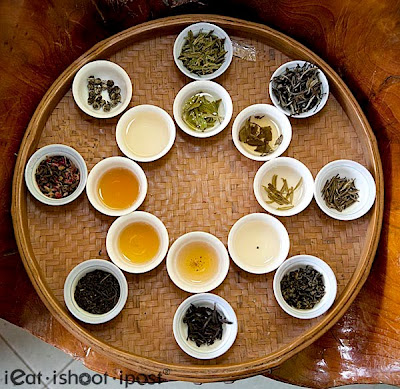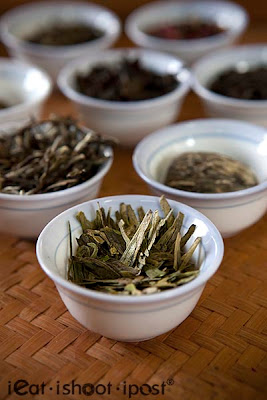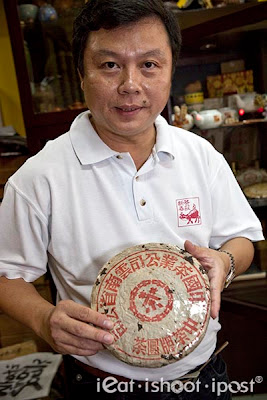
Various Chinese Teas from 10 o'clock White tea and moving clockwise to green, yellow, Oolong and Black Teas
If I asked you what is the most expensive beverage in the world, most people would probably think of a bottle of vintage wine or brandy. But from what I hear from our Tea Merchant from Peh Sin Choon, I reckon the most expensive beverage in the world might just be Chinese Tea.
Legend has it that the mother of a Ming Dynasty Emperor was cured of an illness by drinking tea from 4 particular bushes in the Wuyi mountains of Fujian province. As a result, the Emperor sent four red robes to honour the tea bushes and thus the legend of Da Hong Pao Tea was born. Three of these bushes are still existing today and produce just a handful of the original Da Hong Pao tea each year. The price of the tea has reportedly reached millions of dollars per kg. The tea is so valuable that when Richard Nixon visited China, Chairman Mao presented him with 50g of this Tea as a gift. Richard Nixon as apparently insulted with what he considered was a small gift until it was pointed out to him that the gift represented half of the year's Da Hong Pao harvest!
Da Hong Pao tea can of course be found at good tea houses, but they are of course not from the original three bushes. They are however grown from cuttings of the original tea bushes and processed the same way. I guess most people would never have the chance to taste the original Da Hong Pao, so who can really say how different the this is compared to original Da Hong Pao?
Jasmine Tea
If you enjoy food, then one of the things you have to contend with is your cholesterol levels. Tasty food usually means fatty food which usually means that your cholesterol levels are going to go up unless you consume other foods to balance it out. There are many foods like mushrooms, walnuts and almonds which actually help lower cholesterol levels and it is important to consume them together with foods that contain high levels of saturated fats so that the cholesterol balance is maintained. Another way is to consume a beverage like Chinese Tea with your meals. Pu Erh in particular is particularly good for reducing cholesterol levels.
Over the last few years of blogging about food, I have actually more concerned about what I eat and have slowly switched from drinking Coffee and Milo to Chinese Tea. First of all, I really don't need the extra calories from the sugar and the milk and secondly I wanted the antioxidant and cholesterol lowering properties of Chinese Tea.
Now, there are a huge number of Chinese Teas and if you are like me a few years ago, whenever the waitress at the Dim Sum restaurant asked what tea I would like to have, I would just utter one of the teas I have in my Mandarin vocabulary, just to get the process over and done with. However, I begin to realize that Teas, just like wine, can be paired with different sorts of food. So it pays to understand a little about Chinese Teas so that you can look more like an expert the next time the waitress asks for your choice of tea.
All teas, whether English or Chinese originate from a single plant species, namely the Camillia Sinensis. Just like how milk can be made into many different types of cheeses, the type of tea produced depends on where the tea is grown and how the tea leaves are processed after the harvest. Basically, if very little is done, you get green tea. If you leave it to wilt before frying, you get fermented tea which can be semi fermented, Oolong tea or a fully fermented and aged black tea like Pu Erh tea. The Chinese Red Teas are what the English call Black Tea which is your familiar English Breakfast tea. These teas are fermented and fried to achieve a high level of oxidation. In general, Chinese Teas can be divided into six different classes of teas depending on the way it is processed, viz: Green, White, Yellow, Oolong, Red, Black and Flower teas where dried flowers are used to add an extra dimension to the tea, eg Jasmine tea. 
As with all things there are good quality teas and bad ones. If you have been drinking the $1 per head tea at Dim Sum Restaurants, you probably have been drinking mediocre tea all this while. Just like wine, one of the ways you can tell a good tea from a mediocre one is by looking at the clarity. Good teas are nice and clear while mediocre teas are cloudy. There is then of course colour, taste and fragrance which you can get into to grade your tea.

Another way of telling if your tea is a good tea is to look at the tea leaves themselves. Take the white Dragon Pearl tea for instance, these teas are meticulously hand rolled into little balls which unfurl into nice whole tea leaf shoots when steeped in hot water. The white dragon pearl is actually a white tea which has been scented with Jasmin flowers, so it belongs to the category of flower teas. White teas are called white because they have a white streak which are formed by the furry edges of the tea leaves.
Here's a point to note when you are steeping teas. You might have learnt that you need to steep tea in boiling hot water. Well, this is true for black and red teas like English breakfast and Pu Erh but it does not apply to green teas. Green Teas need to be handled gently and steeped at 70 degrees. In general, the less oxidised the teas are the lower the temperature of the water needed to extract the flavours of the tea.

So, you find yourself sitting in a restaurant and the waitress comes over to ask what type of tea you would like to order. How do you decide? Well, as a general rule the less oxidised teas like Green and White teas are mild and fragrant and go with foods that are steamed and more delicate in taste. If you are going for deep fried foods, oily or spicy food, then go for a Red or Black Tea. The table below provides some tea pairing suggestions which you may find useful.
One of the Teas which you might want to get familiar with is perhaps Dragonwell (龙井) tea. This is a green tea and thus has high levels of antioxidants. It is often regarded as China's Imperial Tea and is frequently used to serve visiting dignitaries. In other words, by choosing Dragonwell instead of Crysanthemum, you show a bit of class. This tea is great if you are going to choose lots of steamed items for a Dim Sum meal. It is also one of the easier teas to recognise as the leaves are a typical blade shape and green in colour.
|
Tea Type
|
Tea Species
|
Food Combinations
|
|
Green Tea
绿茶
|
Green Tea, Dragonwell, Bi Luo Chun
绿茶,龙井,碧螺春
|
Seafood, steamed food
海鲜,蒸煮食物
|
|
White Tea
白茶
|
Silver Tip White Fur, White Peony, Shoumei
银针白毫, 白牡丹,寿眉
|
Seafood, steamed food
海鲜,蒸煮食物
|
|
Yellow Tea
黄茶
|
Jun Shan Silver Tip, Huo Shan Yellow Sprout, Meng Ding Yellow Tip
�山银针,�山黄芽,蒙顶黄芽
|
Seafood, steamed food
海鲜,蒸煮食物
|
|
Oolong Tea
乌龙茶
|
Charm of Buddha Palm, Royal Red Robe, Dong Ding Oolong, Tie Guanyin, Unknown Fragrance, Huangjin Gui
佛手神,大红�,冻顶乌龙,�观音,著��知香,黄金桂
|
Meat items, spicy food
肉类食物,辛辣食物
|
|
Red Tea
红茶
|
Dian Hong, Lapsung Souchong, Qimen Red Tea
滇红,æ£å±±å°�ç§�,ç¥�门红茶
|
Strong flavoured food, fried food, spicy food
��味食物,煎炸食物,辛辣食物
|
|
Black Tea
黑茶
|
Puer Tea, Liu Bao Tea
普洱茶,å…å ¡èŒ¶
|
Strong flavoured food, fried food, spicy food
��味食物,煎炸食物,辛辣食物
|
|
Flower Tea
花茶
|
Jasmine Tea, Rose Puer, Dragon Pearl, Lychee Red Tea, Osmanthus Oolong
茉莉花茶,玫瑰普洱,特级龙ç� ,è�”æž�红茶,桂花乌龙
|
Desserts, cake
甜�,蛋糕
|
Here's a useful chart that shows examples of the different categories of Chinese Tea and how to pair them with food. Personally, I like Long Jing for its fresh grassy notes and White Dragon Pearl. If you like something that will make you go "Ay?", then Lychee Red and Osmanthus Oolong will give you that effect because of its fruity and bright floral fragrance. I also drink quite a lot of Pu Erh because of its cholesterol lowering effects. If it is high oxidant levels you are after, then go for a white tea.

Conclusion
There is still so much more to learn about Tea and I hope that this primer will help give you an overview about this fascinating subject which is quite important to your health as well. Many thanks to Mr Kenry Peh from Pek Sin Choon Tea Merchants who hosted our tea tutorial!
NB: Pek Sin Choon is the oldest Tea Merchant in Singapore and was founded in 1925. Pek Sin Choon is the largest distributor of Teas to our Bak Kut Teh hawkers. According to Kenry, his by the time his grandfather migrated to Singapore, Bak Kut Teh was already sold on our streets.
If you are interested to learn more about Tea, do write in to let me know. If there is sufficient interest, I will try to organize a session for you guys.
Pek Sin Choon
36 Mosque Street
Singapore 059514
63233238
8am to 7pm
Closed Sunday and PH